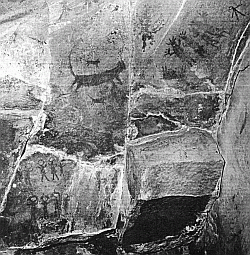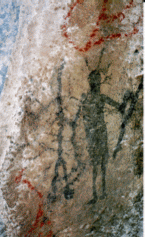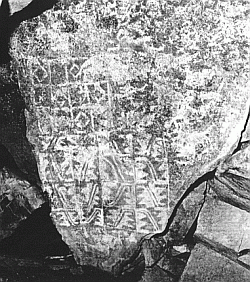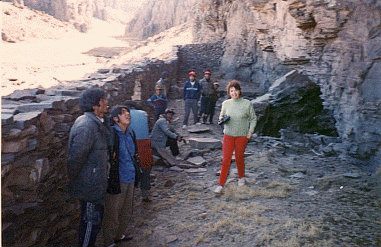NEWS 97
THE
CHICHILLAPE
CULTURE
&
CONSERVATION
MEASURES
Léo
DUBAL*, Maximilien BRUGGMANN**
* Virtual Laboratory for
Archaeometry,
** Reporter-Photographer, Condemines 21, CH-1400 Yverdon
(Switzerland)
At
4500 m.over see level, 120 km off the
west coast of lake Titicaca, not far from Mazo-Cruz,
the archaeological site of Qu'elcatani,
Terrenos de Chichillape,
deserves special attention.
In aymara language, "Qu'elcatani" means
the "written
stone".
According to Simone WAISBARD, this Rock Art Sanctuary has always been
well
known to the Chichillape people,
but remained unknown to the outside world until the
oldest inhabitant,
Clemente CHAMBILLA, mentioned its existence to a Rock Art amateur,
Carlos de AMAT [1].
Around 1968, Jean-Christian SPAHNI, the Geneva's ethnologist who died
3 years ago,
might well have been the first foreigner to visit this site [2].
Finally, in
1976, BRUGGMANN made the first photographic recording of the site [3].
This
site is located under a rock shelter,
facing North, not exposed to direct sunlight, rain and wind.
There is a 26 meter long and
6 m high wall, covered with polychrome (red ochre, white and black)
paintings,
depicting
guanacos and other members of the camel family,
pumas and other predators,
anthropomorphs (see Fig. 1),

Fig. 1 Dancing Rayed-Head
Chichillapes and Puma
(in red ochre) / Photo Bruggmann
hunters
and traps (see Fig. 2)

Fig. 2 :
Guanaco hunter
Photo Dubal
and
decorative patterns such as the one still
in use on aguayo tissues (see Fig. 3).

Fig
3 "Aguayo" Decorative Pattern ( in ochre and white)
Photo Bruggmann
Due to their protective
environment, those
paintings might be quite old, though,
to our knowledge, no
C14-datation has
been made so far. In favour of the high antiquity hypothesis,
SPAHNI [1] argued with the
representation of the long ago disappeared hippocamelus antisensis.
On
Fig. 1 are depicted (dancing ?)
"Rayed-Head Chichillapes", painted in red ocher at Qu'elcatani.
They remind of
iron-age "Rayed-Head Camunians" engraved at Zurla and Foppe
di Nadro in
Valcamonica [4].
Against
the high antiquity hypothesis, one
has to compare those "Rayed-Head Chichillapes",
with the "Rayed-Head
Wenatchees" painted in the Columbia Plateau [5].
KEYSER elaborated a chronological scale, according to which,
the style of the
"Rayed-Head Chichillapes " would correspond to the
mid-"Riverine
Phase", i.e. 1500 years old.
Similarly to the Rayed-Heads from the Columbia Plateau,
the Chichillape Rayed-Heads appear
sometimes with Rayed-Arcs, and do not present an
obvious sexual identity.
In the composition of Fig. 1, one should
notice, left to the upper
"Rayed-Head People",
the "falling Rayed-Head animal".
According
to the local Aymaras, excavation
works (directed by Mark Aldenderfer)
took place a few months before the visit of DUBAL, in August
1993.
The holes have been left open and are visible on Fig. 4.
Nice, light flint arrow-heads, with a length of 15 to 20 mm,
have been found.
The shape of those artefacts coincides, on KEYSER's scale
[5], again with 1500 BP.
In our opinion, the "aguayo patterns" (Fig. 3)
speak also in favour
of low antiquity.
On
Fig. 4, the dry stone wall - erected in
reaction to an act of vandalism and theft
by foreign tourists - is
clearly recognisable.

Fig 4: The
Rock Art Sanctuary of Qu'elcatani
(from inside de newly protected area)
Photo: Dubal
This
protective wall is the result of the
initiative of
the brothers Aries and Francisco ALBINO who led the
Chichillape Community.
It is an excellent example of a remote rural community,
conscious and proud of its
invaluable cultural heritage, taking appropriate conservation measures,
without any
outside support.
For the Quelcatani Rock Art Gallery
Click here
[1] Simone
WAISBARD, Tiahuanaco, R. Laffont,
Paris (1971), pp. 326-335
[2]
Jean-Christian SPAHNI, Semblanza de Los Pueblos
del Peru, Peruano-Suiza, Lima (1971), p. 12
[3]
Maximilien BRUGGMANN & Simone WAISBARD, Die
Kultur der Inkas, Atlantis, Zurich (1980), p. 20-21
and Les Incas, Arthaud, Paris (1980), p.
20-21
[4]
Léo DUBAL, Tactigraphy, a New Method
for
Recording Prehistorical Rock Engravings", INORA, 10 (1995),
p. 23
[5[
James D. KEYSER, Indian Rock Art of the
Columbia Plateau, U. Washington Press, Seattle (1992), p. 25
contact
back
09/20/09 19:27



